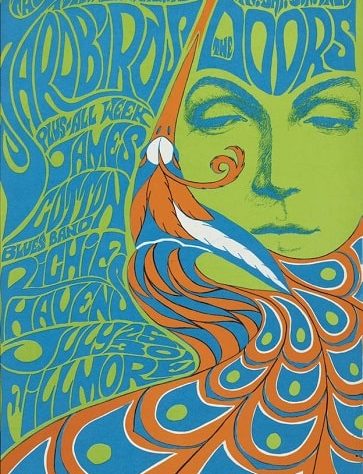- Art Deco
Art Deco was a design movement that was popular from 1920 to 1939. This movement was, in a sense, an amalgamation of various styles and movements of the early 20th century, including Constructionism, Cubism, Modernism, Bauhaus, Art Nouveau, and Futurism. Its popularity peaked in the 1920s, Art Deco was purely decorative. In those days, this style was considered elegant, functional, and ultra modern. which affect the decorative arts such as architecture, interior design, and industrial design, as well as the visual arts such as fashion, painting, graphic arts, and film.
Art Deco features:
Bold use of curve strokes.
tiered form.
Sunshine motif and chevron pattern.
- Swiss Style
Swiss Style is a graphic design style that emerged and developed in Switzerland in the 1950s, this style emphasizes clarity of information, objective and rational composition and the dominant use of typography. At first this style was often called the International TypographicStyle because of the use of typography that was more dominant.
Swiss Style Features:
The use of mathematical grids to create a coherent and orderly structure.
Asymmetrical balance.
Use of photography.
Sans serif fonts are mainly Helvetica and Akzidenz Grotesk.
Swiss Style emphasizes the use of minimal visual elements such as typography and content layout rather than textures and illustrations.
- Futurism Style
Futurism style emerged in Italy in 1909, led by Tomasso Marineti. This style refers more to the renewal of a more optimistic future modernity. Which was originally conceptualized in the literary movement. Then penetrated into the arts such as: painting, architecture, music, sculpture and design.
Features of Futurism:
The unification of the character of the different elements in a reference, and the arrangement of his work as a whole.
Having ideas such as closedness, impatience, extreme in direct relation to futurism values.
Its characteristics also include uneven lines that communicate the energy of its movement.
A view of the work that is concerned with the future.
- Cuban Posters
Cuban Posters style appeared in Cuba in the 1960s, this style poster design for campaigns with the theme of a country of solidarity and ideology.
Cuban Posters features:
Using a wide variety of pop-art styles, psychedelia, and folklore.
Displays contrasting colors.
Voicing revolution, socialist racism.
Cultural and political posters in various visual styles.
- Kitsch
In the world of kitsch art, it is usually used to mean that a work has an excessive (sentimental) value, is vulgar, and has a certain meaning. The style of kitsch style is considered as “outsiders art”, the term kitsch is rarely found in graphic design, but is represented by the term “50s era”.
Kitsch features:
Use of more interesting and varied colors.
Using the principle of title and sub-title.
Use a mix of other techniques such as photography and collage.
Over sentimental and vulgar. Kitsch Design
The need for digital IT is needed in daily activities, Bead IT Consultant is the right choice as your partner, visit our website by clicking this link: www.beadgroup.com

